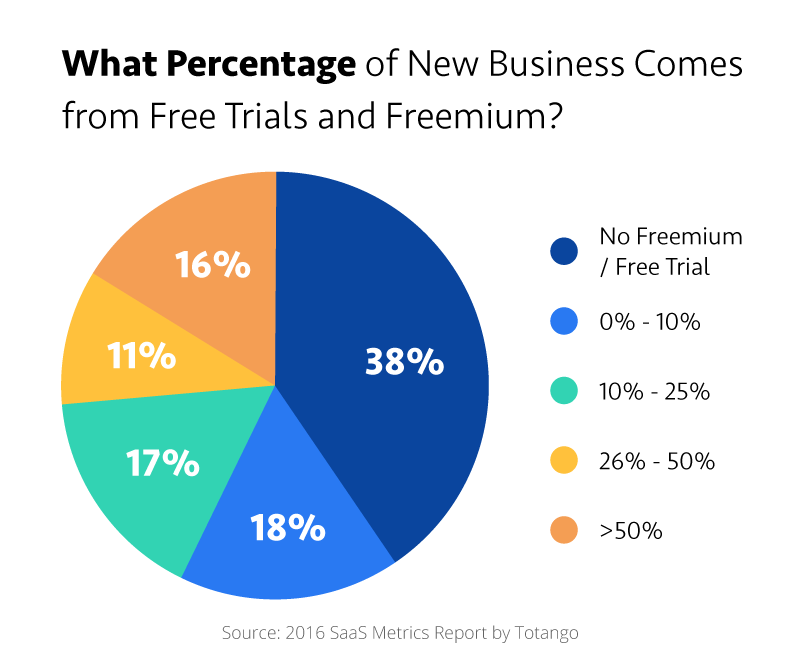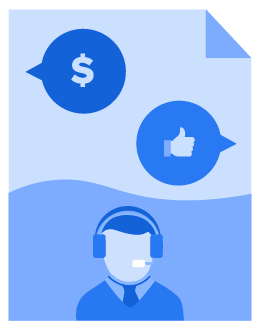SaaS free trial best practices are your guideline for creating a free trial program that converts users into customers. The main goal for a SaaS free trial is to show potential buyers that your software can meet their needs, and to ultimately win their business.
Our expertise at EBQ is helping B2B software companies drive more sales. We’ll focus on best practices for B2B companies, but this article should be general enough to give any SaaS company a place to start with their free trial.
- How long should your free trial be?
- Should you ask for credit card information up front?
- How do you design a free trial journey that converts?
Do free trials increase sales?
Yes, free trials have the potential to increase your software sales. Most companies that use free trials say free trials account for up to 10% of new sales, according to a SaaS Metrics Report by Totango.
And the top 27% of SaaS companies using free trials say they get 25% or more of their new business from their trial, according to the same report.

SaaS free trials are not suitable for every company. But if you can find a trial model that works well for your product and combine it with a data-driven strategy for user engagement, you’re well on your way to increasing sales.
SaaS free trial best practices
How can you set up your free trial so that your software’s value is obvious and the user experience isn’t devalued by the nature of a trial run?
1. Choose suitable limitations for your trial.
The 2 main types of trial limitations are time-limited and feature-limited. Solely time-limited SaaS trials allow a user to access the full product and all its capabilities for a set period of time. Feature-limited trials remove certain capabilities of your software during the free trial.
- Limiting the number of times a user can perform a certain action
- Limiting the capacity of data that can be uploaded
- Disabling/restricting access to certain functions
- Altering the software’s output (example: watermark on saved work)
Some companies choose to combine the 2 types of limitations, enforcing a time limit while also limiting the features that a free trial user can access. Feature-limited trials without a time limit are often referred to as “freemium” products.
Freemium vs. free trial?
Freemium SaaS products let users try out the software for an unlimited amount of time, but the features they can access are limited. In contrast, free trials have a strict time limit in which users can access the (usually full) product or suite of tools.
For most companies, we recommend a time-limited free trial as opposed to the freemium model.
- Users don’t get to experience the full software, so they might not see the value in using it.
- Freemium users might be too satisfied with the free version and never consider upgrading.
Conversion rates for freemium products are typically in the single digits. If the vast majority of your users don’t convert, they better be providing value in some other way: word-of-mouth, brand evangelism, etc.
Think about the give and take of your free trial limitations. Should you allow all access for a short time period? Or should you give a preview of the one feature you know most users want but limit access to it in the trial? It depends on what your product does. You want the value of your software to be easily recognizable, but you don’t want your users to take advantage and get full value for free. Find this balance with your limitations.
2. How long should a free trial be?
The duration of your free trial depends on the complexity of your product and your average selling price (ASP).
A free trial length of 14 days is suitable for 99% of companies, says Steli Efti, Founder and CEO of Close, on the close.com blog. We commonly see 30-day free trials, but a shorter trial length might actually be more effective for most.
The reason a shorter trial might be more effective comes down to how users typically interact with free trials. Most SaaS products are not the kind you interact with every day for 30 days.
And offering a shorter trial creates a sense of urgency: users are compelled to see what your product has to offer in that shorter window of time they have to use it.
Of course, you need to think deeper about how users actually use your product. Does it take longer than a few minutes to onboard and set up the software before it’s useful? How long does it take for a user to get results from your product? If it takes more than 14 days for the value of your product to become apparent, you will most likely need a longer free trial duration.
3. Free trial with or without credit card?
It’s OK to ask for credit card information for your free trial if you have a heavy amount of website traffic and a well-known product. Handing over payment information is a significant point of friction for most trial users, so you should anticipate fewer signups.
In many cases, only visitors who trust your brand or who strongly believe your product can meet their needs will give you their credit card details. This means a smaller proportion of visitors who actually become trial users.
On the other hand, these users are often more qualified and convert to paid customers at a higher rate. The average trial-to-customer conversion rate for opt-out trials (trials that require a card) is about 35% higher on average than opt-in trials (trials that don’t require a card), according to the SaaS Conversions Benchmark report by Totango.

However, the same Totango report found that the 90-day retention rate for opt-out free trials was 20% lower than the opt-in free trials. This is most likely because companies that don’t require a credit card must double down on user experience and enablement in order to acquire those customers.
In the end, asking for a credit card before your trial sign-up can decrease the number of new customers you win and retain. Still, it could be appropriate if you have significant website traffic and anticipate a lot of sign-ups.
But letting users access your free trial without requiring a card will most likely increase your number of sign-ups.
- Offering a valuable product and a first-rate user experience
- Keeping users engaged and motivated to convert to paid customer
4. Persistently follow up with trial users.
Here’s a common scenario: a user signs up for a free trial, tests it out for a few minutes, thinks about purchasing it later, then forgets about the free trial forever.
The unfortunate truth is 40-60% of SaaS free trial users will use the product once and never sign in again.
Scenarios like the one above are why you can’t let your free trial exist in a vacuum. SaaS companies need to take a strategic approach to engaging their trial users and nudging them toward a conversion. We recommend 2 types of follow-up to keep your software top-of-mind: sales development and email marketing.

Interested in the Best Cold Calling Scripts for Software Sales?
Our guide includes sales expert’s insights and best practices. Free for anyone who’s ready to create high-converting scripts.
Improve free trial conversions with sales development
Our go-to tactic for helping B2B SaaS companies improve free trial conversions is following up on users with a 1-to-1 sales call. We have sales development reps who reach out to free trial leads, discover more about their needs, and warm them up until they’re ready to schedule a call with a closing sales rep.
An SDR makes different types of sales touches — direct calls, voicemails, 1-to-1 emails — where they reiterate the biggest benefits of your SaaS product and anticipate potential objections to purchasing.
SaaS is known for shorter, transactional sales cycles. But many B2B SaaS companies face long sales cycles, particularly if they have a high selling price or large average deal sizes including multiple licenses. An SDR team speeds up long sales cycles by warming up free trial leads, qualifying them for sales, and setting sales appointments.
You can learn more about this sales development strategy in our Ultimate Guide to B2B Appointment Setting.
Free trial email marketing campaigns
Your marketing team can work alongside a sales development team, nurturing free trial users with email marketing automation.
- Welcome emails, sent immediately after sign-up
- Usage tips and tutorials
- Invitations to educational webinars
- Trial expiration reminders
- Emails requesting user feedback
Your email marketing strategy should leverage blogs and other informational content, and focus on assisting throughout the user journey. Email automation platforms let you set up drip campaigns, which use conditional logic and trigger events to determine when a user should be sent what.

At EBQ, we use Salesforce Pardot for email marketing automation, as it seamlessly syncs with our Salesforce CRM and allows great visibility into the entire lead nurturing process. If you’re looking for more information about setting up these drip email campaigns, you should read our B2B Marketer’s Guide to Pardot.
Email automation is incredibly effective for keeping users engaged with your free trial and encouraging them to take the next step on your platform.
When you teach your users how to be successful and show them exactly how the software meets their needs, you can better motivate them to become a paid customer.
5. Map your free trial user journey.
Pay close attention to how users utilize your free trial, and where they typically lose interest and fall out of your pipeline. Analyzing usage helps you identify bottlenecks and other key events that you can leverage in your communications.
Key events are stops along the user journey, actions or behaviors a user performs on your platform which reveal something about their intentions.
Some free trial key events you might observe and track:
- Completing an action within the software (example: creating a list)
- Logging in frequently or for a long duration
- Completing a tutorial or guided walkthrough
- Inviting another user to try out the platform
- Completing a demo call with a sales rep
Some SaaS companies refer to a key event as the “aha moment,” the moment where a new user first realizes the value in your product and its ability to meet their needs. Knowing how key events correspond with conversion tells you which users are serious about your product. You can prioritize reaching out to these prospects and create urgency with both in-app and external communications.
We recommend tracking the entire user journey — from website visitor to customer — to identify the strongest points in your funnel or remove any barriers to conversions.

For example: If you observe only 39% of people who view the sign-up page actually complete the sign-up for your free trial, you could try revamping that page with a demo video or fresh copy.
Another example: You observe that 72% of trial users start setting up their profile, but 41% leave the trial once it asks them to link their email account. You also observe that 88% of trial users who complete their profile end up purchasing. You identify profile completion as a key event and fix the bottleneck by allowing users to skip the email account step.
Keep an eye out for when and why users abandon the free trial journey, so you can make the changes necessary to hold their interest.
6. Prioritize your onboarding process.
An effective onboarding process is an important factor in a customer’s decision to pay for — or continue paying for — your SaaS product. The onboarding process is your first chance to create that “aha moment,” convey the value of your software, and set the user up for success.
Onboarding messaging should teach them what they need to know in order to use your product successfully. The onboarding process for a free trial should be as simple as possible, so your users can put your product to the test right away.
Guide them through onboarding with relevant in-app notifications, tutorial videos, and educational email content that tells them how to take the next step. This is a chance to leverage those key events you’ve identified and assist through common roadblocks. This is also a prime opportunity to get a free trial user on the phone with a representative, by offering a 1-on-1 walkthrough from one of your product experts.
- Increase engagement with your free trial
- Increase customer convenience
- Increase customer retention over time
An ineffective onboarding process is one of the top reasons SaaS customers churn. Companies need to emphasize the service in software-as-a-service and provide the support needed to succeed with their product.
If you’ve yet to build out your customer success team, EBQ’s Customer Experience service can help you execute a consistent and valuable onboarding process. If you want to convert and retain more trial users, consider adding our experienced Onboarding Specialists to your team.
Improving SaaS free trial conversion rates
SaaS free trial best practices heavily depend on what your software does and how your customers use it. What is the “aha moment” your users are looking for? And what is the fastest way to get them to it?
Choose limitations that give users a chance to experience your product’s value, but don’t give away all the value for free. Understand the key events that motivate your triers to become buyers, and leverage those to keep them engaged. Analyze the user journey journey and follow-up with your most invested prospects.
And if you need help improving trial conversions — whether you need extra sales reps, email marketing help, or SaaS onboarding expertise — don’t hesitate to contact EBQ for some guidance.


